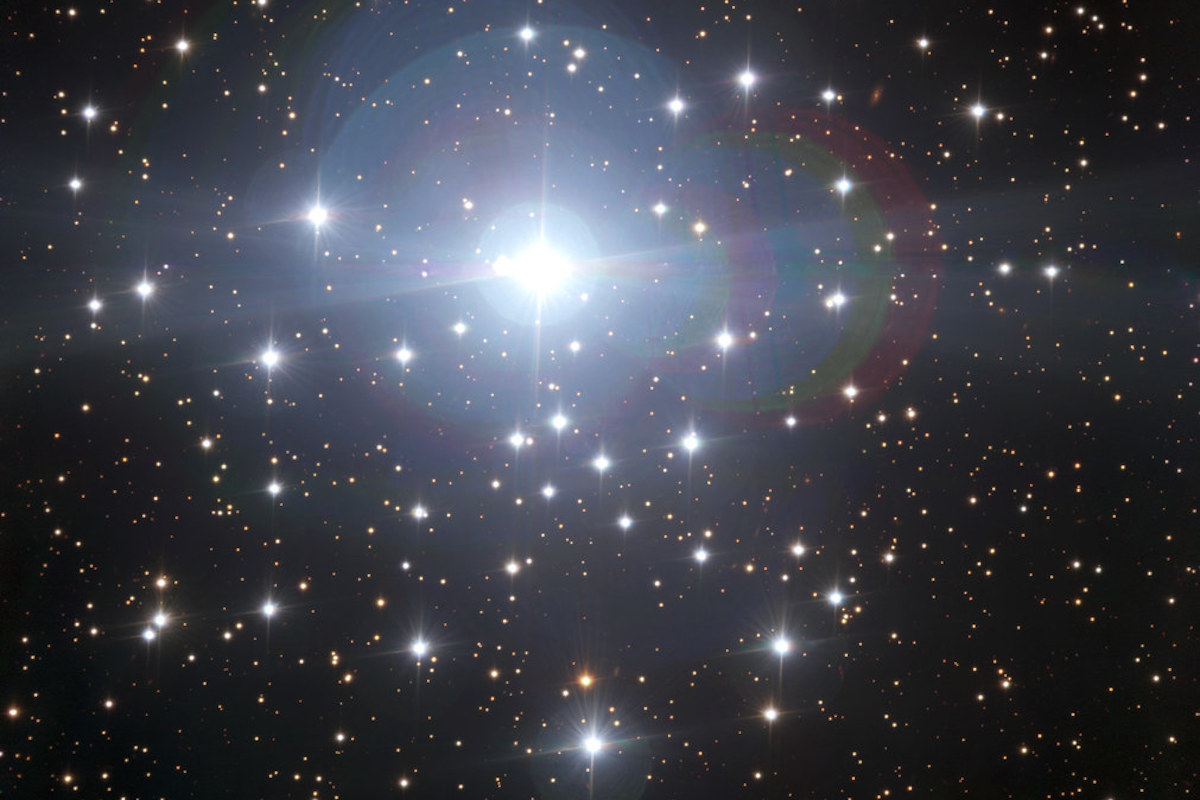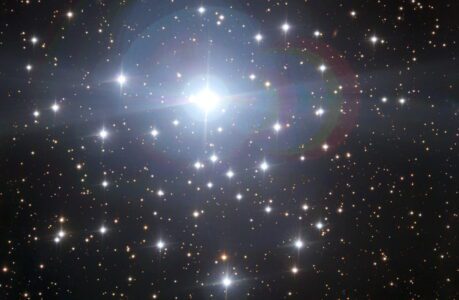Canis Major is one of the most prominent constellations in the night sky. Located in the southern hemisphere, it is best viewed during the winter months from Ireland. The constellation is dominated by the bright star Sirius, also known as the Dog Star, which is the brightest star in the sky after the Sun.
In this article, we delve into the fascinating history and mythology behind Canis Major, and provide tips on how to best view this celestial wonder from Ireland.
The History and Mythology of Canis Major
Canis Major has been known to humans for thousands of years. In ancient times, many cultures associated the constellation with dogs, wolves, or other canines. For example, the ancient Egyptians believed that Sirius represented the god Anubis, who had the head of a jackal. The Greeks associated the constellation with the dog Laelaps, which was famous for its speed and agility.
In Greek mythology, Canis Major was associated with the legendary hunter Orion. According to the myth, Orion was accompanied on his hunts by two faithful hunting dogs, which were represented by Canis Major and the nearby constellation of Canis Minor. In some versions of the myth, Canis Major was said to be the dog of Procris, the wife of Cephalus.
The Dog Star, Sirius
The brightest star in Canis Major is Sirius, which is also known as the Dog Star. Sirius is a binary star system, consisting of a main-sequence star (Sirius A) and a white dwarf companion (Sirius B). The two stars orbit each other every 50 years, and Sirius B can only be seen with a telescope.
Sirius is the brightest star in the sky after the Sun, with an apparent magnitude of -1.46. It is also one of the closest stars to Earth, with a distance of only 8.6 light-years. Sirius is a highly visible star, and is often used by astronomers as a benchmark for brightness and colour.
Viewing Canis Major from Ireland
Canis Major is best viewed from Ireland during the winter months, when it is high in the southern sky. The constellation can be seen from almost anywhere in Ireland, as long as there is clear, dark skies.
To get the best view of Canis Major, it is important to find a location with minimal light pollution. The countryside or coastal areas are ideal, as they are typically less affected by light pollution than urban areas.
Binoculars or a telescope can be used to enhance the viewing experience. With a telescope, it is possible to see the white dwarf companion of Sirius, Sirius B. However, even without a telescope, Canis Major is a spectacular sight to behold, with its bright stars and distinctive shape.
Conclusion
Canis Major is a prominent and fascinating constellation that has captivated humans for thousands of years. Its bright star, Sirius, also known as the Dog Star, is one of the most recognizable and celebrated stars in the sky. From Ireland, Canis Major is best viewed during the winter months, and with clear, dark skies, it is a breathtaking sight to behold.
How can I see the constellation of Canis Major from Ireland?
To see the constellation of Canis Major from Ireland, you need to wait for the winter months when it is high in the southern sky. Here are some steps you can follow to view Canis Major from Ireland:
- Check the weather forecast: Make sure the sky is clear of clouds and the weather conditions are favourable for stargazing.
- Find a location with minimal light pollution: Look for a spot away from city lights, streetlights, and other sources of light pollution. The countryside or coastal areas are ideal for stargazing.
- Wait for the right time: Canis Major is visible in the night sky during the winter months, from around November to March. Look for it between 8 PM and 11 PM, when it is at its highest in the sky.
- Look for the brightest star: Canis Major is dominated by the bright star Sirius, also known as the Dog Star. It is the brightest star in the sky after the Sun, and its distinctive brightness and colour make it easy to identify.
- Observe the constellation: Once you have located Sirius, look for the constellation’s other stars. Canis Major is characterized by a distinct shape, which resembles a dog standing on its hind legs. The constellation’s other stars form the dog’s body and legs.
- Use binoculars or a telescope: If you have binoculars or a telescope, you can enhance your viewing experience and see more detail in the constellation. With a telescope, you may even be able to see Sirius’s white dwarf companion, Sirius B.
Remember to dress warmly and bring a blanket or chair to sit on while stargazing. With clear skies and the right location, you can witness the beauty of Canis Major from Ireland.
The mythology of the constellation of Canis Major
The constellation of Canis Major has a rich history and mythology that dates back to ancient times. In many cultures, the constellation was associated with dogs or wolves, and its brightest star, Sirius, was often considered a significant celestial object.
In ancient Egypt, Sirius was associated with the goddess Isis and the god Anubis, who was often depicted with the head of a jackal. The rising of Sirius in the sky was an important event for the Egyptians, as it marked the beginning of the Nile flood season.
In Greek mythology, Canis Major was closely associated with the legendary hunter Orion. According to the myth, Orion was accompanied on his hunts by two faithful hunting dogs, which were represented by Canis Major and the nearby constellation of Canis Minor. In some versions of the myth, Canis Major was said to be the dog of Procris, the wife of Cephalus.
In another version of the myth, Canis Major was the dog of King Aeacus of Aegina, who was known for his just and fair rule. When Zeus destroyed the population of Aegina with a flood, Aeacus and his dog were the only survivors. Aeacus later became a judge in the underworld, and his dog was placed among the stars as a constellation.
The Greeks also associated Canis Major with the dog Laelaps, which was famous for its speed and agility. According to the myth, Laelaps was a gift from Zeus to Europa, the daughter of the Phoenician king Agenor. Laelaps was later given to Procris, the wife of Cephalus, who used the dog to catch the Teumessian fox, a beast that was destined never to be caught. In the end, Zeus turned both the dog and the fox into stone and placed them among the stars.
The Romans also had their own mythology surrounding Canis Major. They associated the constellation with the dog of the legendary Roman hero Romulus, who was said to have been raised by a she-wolf. According to the myth, Romulus’s dog was placed among the stars after it died while defending its master’s body.
In modern times, Canis Major is still a popular constellation among stargazers and astronomers alike. Its bright star Sirius, also known as the Dog Star, is one of the most recognizable and celebrated stars in the sky. The mythology and history surrounding Canis Major add to its mystique and make it an even more fascinating constellation to explore.
The Stars in the constellation of Canis Major
The constellation of Canis Major is a prominent constellation in the southern sky. It is located close to the constellation Orion and is easily identifiable by its brightest star, Sirius, which is also known as the Dog Star. The constellation is home to several other stars, including some notable ones that have interesting features.
Here are some of the notable stars in the constellation of Canis Major:
- Sirius (Alpha Canis Majoris): Sirius is the brightest star in the constellation and is also the brightest star in the entire sky. It is a binary star system consisting of two stars, Sirius A and Sirius B. Sirius A is a main-sequence star and is about twice as massive as the Sun. Sirius B is a white dwarf star that is about the size of the Earth. The two stars orbit each other every 50 years.
- Mirzam (Beta Canis Majoris): Mirzam is the second-brightest star in the constellation and is located near Sirius. It is a blue-white supergiant star that is about 6,000 times brighter than the Sun. Mirzam is approximately 500 light-years away from Earth.
- Wezen (Delta Canis Majoris): Wezen is a yellow supergiant star that is about 17 times more massive than the Sun. It is one of the largest known stars, with a radius that is approximately 1,800 times that of the Sun. Wezen is located about 1,800 light-years away from Earth.
- Adhara (Epsilon Canis Majoris): Adhara is a blue-white star that is about 5,000 times more luminous than the Sun. It is located approximately 430 light-years away from Earth and is one of the brightest stars in the sky.
- Omicron Canis Majoris: Omicron Canis Majoris is a double star system that consists of two blue-white stars that are about 3,000 times more luminous than the Sun. The stars are separated by about 6 arcseconds, which is visible with a telescope.
These stars are just a few of the notable ones in the constellation of Canis Major. The constellation also contains many other stars of varying magnitudes and colours that are worth exploring.
Deep sky objects visible in the Constellation of Canis Major
The constellation of Canis Major is known for its bright stars, but it also contains several deep sky objects that are worth exploring. Here are some of the notable deep sky objects visible in the constellation of Canis Major:
- Messier 41: Messier 41 is an open cluster of stars that is located about 2,300 light-years away from Earth. It is one of the brightest open clusters in the sky and is visible with binoculars or a small telescope.
- NGC 2207 and IC 2163: NGC 2207 and IC 2163 are two interacting galaxies that are located about 140 million light-years away from Earth. The galaxies are in the process of merging, and the gravitational interactions between them have caused a burst of star formation.
- NGC 2359 (Thor’s Helmet): NGC 2359 is a diffuse nebula that is located about 15,000 light-years away from Earth. It is shaped like a helmet and is illuminated by a bright star at its centre.
- NGC 2362: NGC 2362 is an open cluster of stars that is located about 5,000 light-years away from Earth. It is a relatively young cluster, with an age of about 5 million years.
- IC 2177 (Seagull Nebula): IC 2177 is a diffuse nebula that is located about 3,800 light-years away from Earth. It is named after its resemblance to a seagull in flight.
- VY Canis Majoris: VY Canis Majoris is a red hypergiant star that is one of the largest known stars in the universe. It is located about 5,000 light-years away from Earth and has a radius that is approximately 1,800 times that of the Sun.
These deep sky objects can be viewed with a telescope or binoculars, and they offer a fascinating glimpse into the wonders of the universe.

